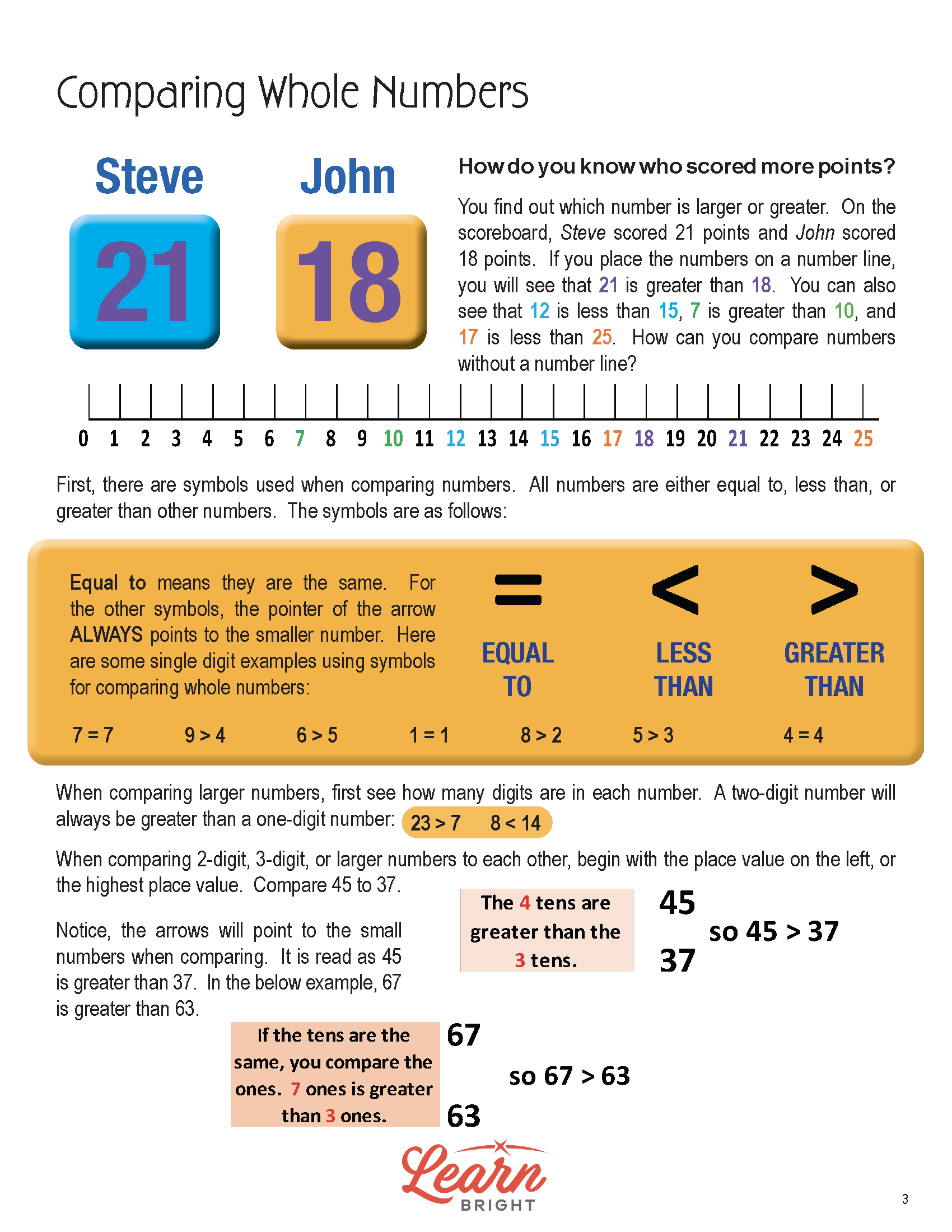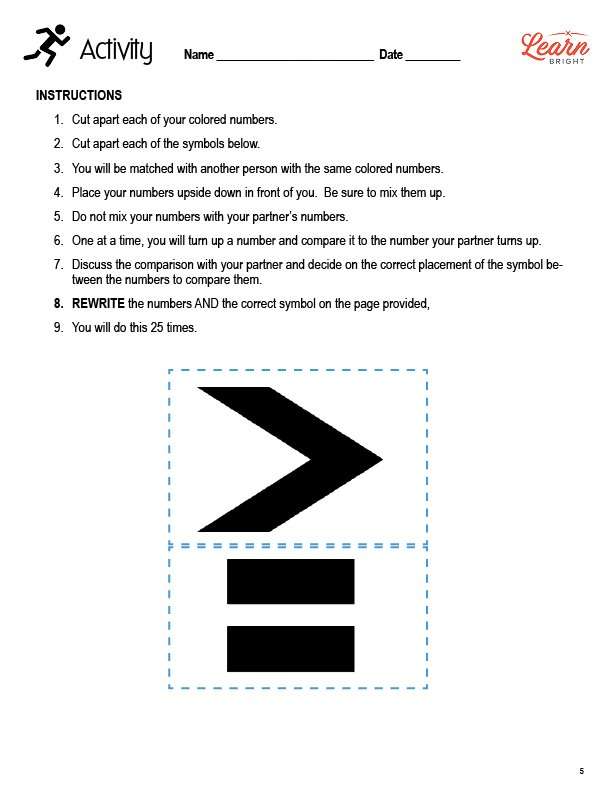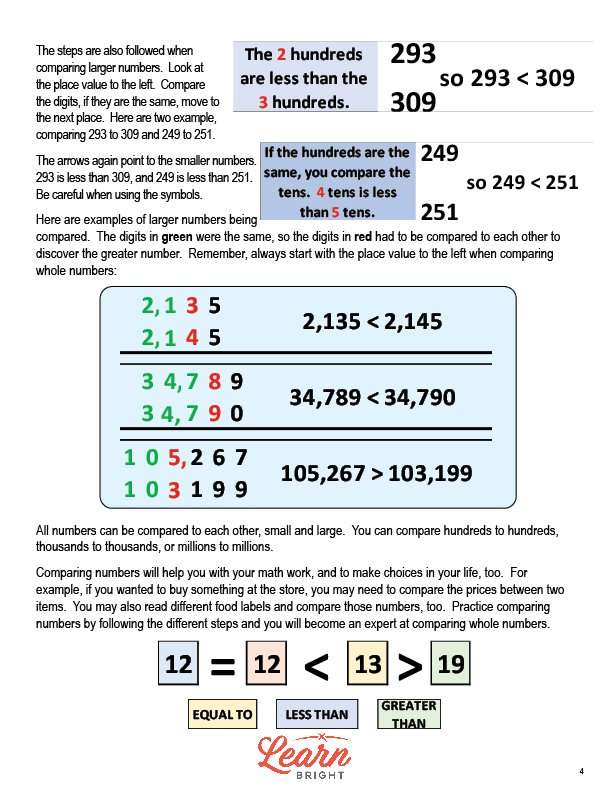Description
What our Comparing Whole Numbers lesson plan includes
Lesson Objectives and Overview: Comparing Whole Numbers develops number awareness as students compare whole numbers. This lesson includes activities with experiential practice for using the correct symbols when comparing whole numbers. At the end of the lesson, students will be able to use the correct symbols to compare whole numbers. This lesson is for students in 1st grade and 2nd grade.
Classroom Procedure
Every lesson plan provides you with a classroom procedure page that outlines a step-by-step guide to follow. You do not have to follow the guide exactly. The guide helps you organize the lesson and details when to hand out worksheets. It also lists information in the blue box that you might find useful. You will find the lesson objectives, state standards, and number of class sessions the lesson should take to complete in this area. In addition, it describes the supplies you will need as well as what and how you need to prepare beforehand. The supplies you will need include scissors and the handouts.
Options for Lesson
Included with this lesson is an “Options for Lesson” section that lists a number of suggestions for activities to add to the lesson or substitutions for the ones already in the lesson. One optional addition to this lesson is to allow extra time for the activity, letting students use each color of numbers. You could also use the colored numbers based on student level. To extend this lesson, you could use this lesson alongside a science lesson related to planet distances, or other similar lesson from other subject areas.
Teacher Notes
The teacher notes page includes a paragraph with additional guidelines and things to think about as you begin to plan your lesson. This page also includes lines that you can use to add your own notes as you’re preparing for this lesson.
COMPARING WHOLE NUMBERS LESSON PLAN CONTENT PAGES
Comparing Whole Numbers
The Comparing Whole Numbers lesson plan includes two pages of content. If you’re playing a game and want to know who has more points, you need to figure out which number is larger. For example, if Steve scored 21 points and John scored 18, you can place those numbers on a number line and see that 21 is greater than 18. But if you don’t have a number line, how can you compare numbers?
We use symbols to compare numbers. All numbers are either equal to, less than, or greater than other numbers. Equal to (=) means that the numbers are the same. For the less than (<) and greater than (>) symbols, the point of the arrow always points at the smaller number. The lesson includes some examples that show how to use these symbols: 7 = 7, 9 > 4, 6 > 5, 1 = 1.
When you’re comparing numbers, you can first check the numbers of digits in each number. Two-digit numbers are always greater than one-digit numbers. When you’re comparing numbers that are 2-digit, 3-digit, or larger, you start by looking at the leftmost (highest) place value. For example, when comparing 45 and 37, the 4 tens are larger than the 3 tens, so we know that 45 > 37.
We follow the same steps for even larger numbers, starting with the highest place value. If those digits are the same, you move on and compare the next place value. To compare 293 and 309, we start looking at the hundreds place. 2 is less than 3, so 293 < 309.
To compare 249 and 251, we start by looking at the hundreds place, but the hundreds place is the same for both numbers. Therefore, we look at the tens. 4 is less than 5, so 249 < 251. The lesson gives several examples with larger and larger numbers with more digits.
We can compare all numbers to each other, whether they’re big or small. We can compare hundreds with hundreds, thousands with thousands, and so on.
Being able to compare numbers is important because it helps you with your math work and helps you make decisions too. If you want to buy something at the store, for example, this will allow you to know which of two items is more expensive. You’ll be able to compare food labels, too!
COMPARING WHOLE NUMBERS LESSON PLAN WORKSHEETS
The Comparing Whole Numbers lesson plan includes three worksheets: an activity worksheet, a practice worksheet, and a homework assignment. You can refer to the guide on the classroom procedure page to determine when to hand out each worksheet.
COLORED NUMBERS ACTIVITY WORKSHEET
For the activity worksheet, students will cut out both symbols and a set of colored numbers. They will work with another student who has the same colored numbers. Each student will place their numbers upside down in front of them, making sure to mix them up. They will then take turns flipping over a number and comparing it to the number their partner flips over. Each pair will decide on the correct placement of the symbol between the numbers to compare them. They’ll write the numbers and comparisons on a sheet of paper.
SYMBOLS PRACTICE WORKSHEET
The practice worksheet asks students to use =, <, or > to compare whole numbers. They will also write the words comparing different pairs of numbers.
COMPARING WHOLE NUMBERS HOMEWORK ASSIGNMENT
For the homework assignment, students will choose the correct answer for each number comparison question. They will also write in numbers that would make each comparison true.
Worksheet Answer Keys
This lesson plan includes answer keys for the practice worksheet and the homework assignment. If you choose to administer the lesson pages to your students via PDF, you will need to save a new file that omits these pages. Otherwise, you can simply print out the applicable pages and keep these as reference for yourself when grading assignments.









